Expert Foot & Ankle Treatment from Michigan’s #1 Podiatrist - Balance Foot & Ankle Specialist
Bruise Under the Big Toenail Treatment!
Causes & Remedies
This Bruise Under the Big Toenail Treatment can work 95% of the time. The SECRET is that the toenail is detached, and you have to trim and file it down!
Look:
- Red toenail & black toenail pain can be improved with a few simple treatments.
- We are foot doctors & we see this problem get better almost every day.
- The goal is to solve this problem without medication or surgery if at all possible.
So, let’s GO!
Toenail Pain (Toenail Fungus, Ingrown Toenails, Discolored Toenails)
Red or Black Toenail Picture & Photo Gallery:
Look:
- A red toenail generally means fresh blood or a fresh injury.
- This can be called a toenail hematoma or fresh blood from repetitive irritation.
- A black toenail is generally more dried blood that has crested underneath the toenail.
- Very infrequently, can a black toenail be something more dangerous like melanoma?
- It is also possible for your toenail to the infected with toenail fungus. This can also then result in rubbing and bleeding after the toenail fungus.
- If there is toenail fungus, this is usually more of a brown or yellow color.
- A toenail falling off is a widespread problem as well.
Please click on the photo gallery for descriptions & full-size photos!
Bruise under the big toenail overview:
- This Bruise Under the Big Toenail Treatment ensures that your toenail will grow back!
- The key is to prevent damage from occurring again.
- It does take a very long time for a new healthy toenail to grow back in.
- This can take up to a year!
- Find out if you are in danger and how to get your toenail back to normal!
Causes of Bruising Under the Big Toenail:
- The cause of bruising under the big toenail is usually due to trauma or chronic irritation.
- This may mean that the nail is ripped or loosened underneath the toenail.
- If this has occurred, bacteria and fungus may get under the toenail in this region.
- A traumatic injury is obvious and is the result of stubbing your toe really hard or dropping something heavy on your toe.
- Chronic irritation usually occurs in people who are on their feet for a really long time, such as factory workers, nurses, and runners.
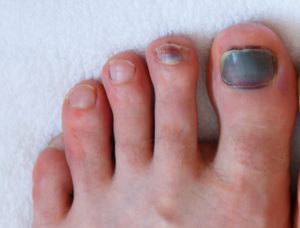
Is It Dangerous?
- No, you are almost always in no danger!
- Very rarely, there can be a skin condition called melanoma, this is dangerous, and you should see a podiatrist immediately.
- This is a very common occurrence that is simply your blood pooling underneath your toenail.
- The pain stops within a couple of days.
- If your toenail is loose, it will grow back in almost all situations!
- The danger is that as the blood pours out under the nail, pressure will build-up, and this can lead to severe pain.
- So if you keep experiencing pain, see your podiatrist!
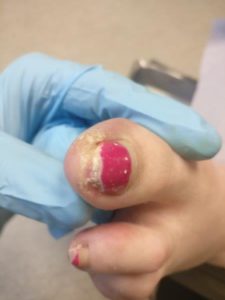
When Is It Dangerous?
- In some people, there is a more dangerous condition called melanoma.
- The only way to be 100% sure is to obtain a soft tissue biopsy.
- This normally extends from the nail into the skin or grows larger as time goes on.
- Bob Marley had this condition on his big toe.
Most Common Causes of a Bruised Toenail:
1) Traumatic Big Toenail Injury:
This happens when you drop something bit on your toe very violently or stub the toe against something very hard!
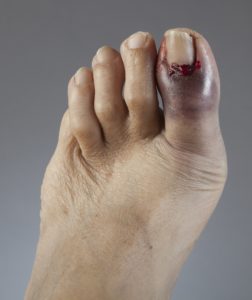
Symptoms:
- Deep aching and throbbing pain!
- It is very obvious what initially caused this pain!
- Due to extreme blunt force trauma.
- The toe develops a bruise and becomes swollen within 30 minutes.
- A red or black bruise develops.
- Bleeding occurs.
Home Treatment Guide:
2) Constant Light Rubbing:
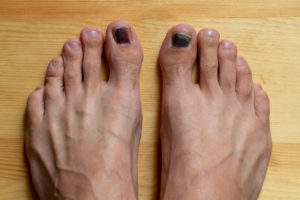
A runner’s toe occurs if the toenail is rubbing against the front of the shoe; even if it is not really painful, blood could accumulate in the form of leakage or blistering under the nail. It usually occurs from tight shoes or a great deal of pressure on the shoe!
Symptoms:
- Not always a pain. It could be painless!
- Not very obvious what caused this. It could very easily sneak up on you.
- Due to wearing tight shoes.
- Due to beginning a new heavy exercise routine!
- The toe develops a bruise over days or weeks of exercising or running.
- A red or black bruise develops.
- Bleeding occurs.
Home Treatment Guide:
3) Toenail Fungus Causing Separation:
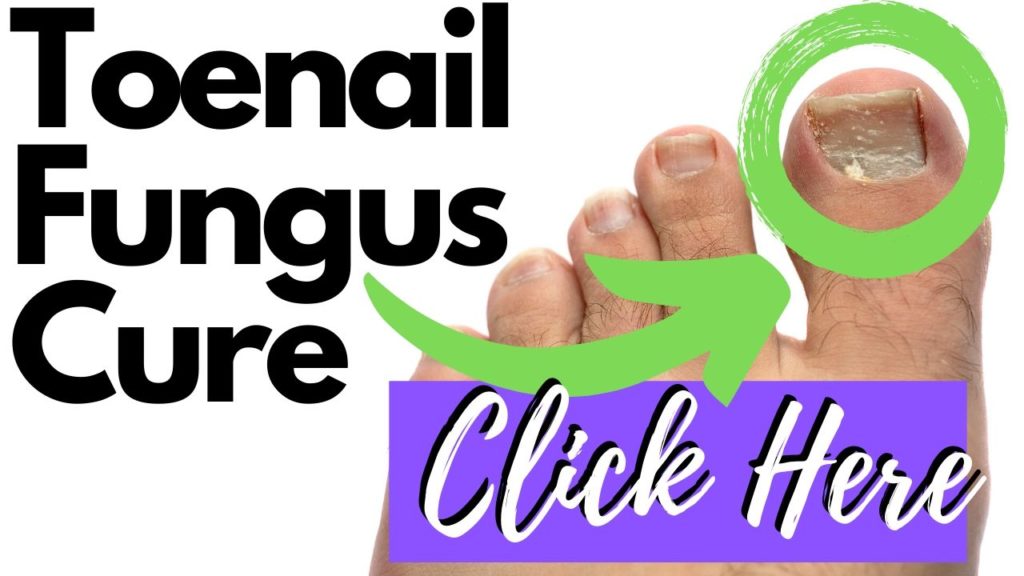
If your nails gradually become thick, discolored, and crumbly under the border, then read our comprehensive guide to toenail fungus.
Symptoms:
- Not always a pain. It could be painless!
- Not very obvious what caused this. It could very easily sneak up on you.
- Yellow, green, or brown toenails.
- No bleeding, but it does look brown.
- Very thick toenails.
- It can be hard.
- It can be very brittle and crumbling.
- Debris is present underneath the toenails.
Home Treatment Guide:
4) Melanoma:
Watch out for a Black Cancerous Mole Under Your Toenail.
- If you don’t remember injuring yourself or have not been running or walking heavily, you might want to consider that you have a mole under your toenail.
- This condition is very rare, but this is a very treatable disease and can save your life if you catch it.
Follow this Diagnosis Guide:
Black Streak in the Toenail or Fingernail Guide
If The Toenail Is Loose, How Long To Regrow?
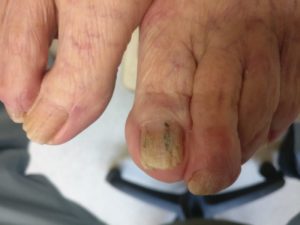
- First, you must accept that if the toenail is loose, it can not be re-attached!
- The toenail will grow back in almost all situations.
- Toenails grow back at approximately 1 millimeter per month.
- This means that if you have lost the distal 3 millimeters of your toenail, it will take approximately 3 months for it to grow back!
- If you have lost the entire toenail (which is approximately 10 millimeters long), it can take about 1 year to grow back that toenail!
- As the toenail grows out, the black spot will move with it.
Bruising or Crust Under the Toenail Treatment Overview:
- Do you want to get your toenail to grow back as quickly as possible?
- Well, the #1 most important thing is to trim and file down the loose, damaged portion of the toenail.
- If you don’t trim up this dead skin and toenail that has no more blood flow, it is impossible to regenerate it.
- Once you trim that loose skin up, you have to prevent a fungal infection from occurring.
Consider these options to help you do that!
Best Toenail Repair Products:
Best Toenail Repair Pen.
Top Choice For Direct Toenail Application.
Great Option For Foot Soak.
Great Tea Tree Oil Treatment




Price:
$14.44
$22.88
$17.97
Price not available
Overview:
4 Pens with quick dry application that leaves a sealing lid on top. Easy to store and apply. Key is still to trim/file the toenail first!
All natural option that is toxic to fungus. This is similar to tea tree oil in that respect but can be more effective. You still need to exfoliate dead skin and trim thick toenails.
Safe, cost effective and relaxing all at the same time! This needs to be used in a 20 minute foot soak. Works well for exfoliating loose skin/toenail as well as softening.
Tea Tree Oil is well studied and an all natural anti-fungal treatment.
Pros:
Easy to use, quick drying. This fills into the cracks and seals them with minimal mess. This is great for sealing even dehydrated keratin granulations.
All natural, relatively cost effective. 1,000s of reviews with excellent results. Very clean and quick drying, easy to apply.
Very safe, little risk, low cost and very effective if used correctly. The key is to use it as an aid to soften and exfoliate loose/dry dead skin and toenail.
Great reviews at 4.7/5 at 500+ overall reviews. Well proven and natural option.
Cons:
0% chance of working if your toenail is loose and has no blood supply. Make sure you trim and file any loose finger or toenail. Otherwise “0% CHANCE OF WORKING!” You cannot restore a dead toenail without blood flow.
Small amount and a little more expensive than some other options. Once more has 0% chance of working if your goal is to heal a dead, detached toenail or dry skin. Are you noticing this is a trend? This is really the key!
It once more has 0% chance working if you are trying to save loose and dead crusty skin. Fungus will always grow on this if no blood flow. It can not regenerate dead skin, only exfoliate it.
Not the greatest amount of solution, the all natural solutions can be more expensive.
Crucial Tips:
There is some evidence that these active ingredients work, just be aware: These are not FDA approved and massively studied medications!
There is some evidence that these active ingredients work, just be aware: These are not FDA approved and massively studied medications!
There is some evidence that these active ingredients work, just be aware: These are not FDA approved and massively studied medications!
Although tea tree oil does nave studies and is antifungal, it is not an FDA approved medication and not studied for this specific use.
Affiliate Link (Buying through these links will connect you to Amazon):
Best Toenail Repair Products:
Best Toenail Repair Pen.

Price:
$14.44
Overview:
4 Pens with quick dry application that leaves a sealing lid on top. Easy to store and apply. Key is still to trim/file the toenail first!
Pros:
Easy to use, quick drying. This fills into the cracks and seals them with minimal mess. This is great for sealing even dehydrated keratin granulations.
Cons:
0% chance of working if your toenail is loose and has no blood supply. Make sure you trim and file any loose finger or toenail. Otherwise “0% CHANCE OF WORKING!” You cannot restore a dead toenail without blood flow.
Crucial Tips:
There is some evidence that these active ingredients work, just be aware: These are not FDA approved and massively studied medications!
Affiliate Link (Buying through these links will connect you to Amazon):
Best Toenail Repair Products:
Top Choice For Direct Toenail Application.

Price:
$22.88
Overview:
All natural option that is toxic to fungus. This is similar to tea tree oil in that respect but can be more effective. You still need to exfoliate dead skin and trim thick toenails.
Pros:
All natural, relatively cost effective. 1,000s of reviews with excellent results. Very clean and quick drying, easy to apply.
Cons:
Small amount and a little more expensive than some other options. Once more has 0% chance of working if your goal is to heal a dead, detached toenail or dry skin. Are you noticing this is a trend? This is really the key!
Crucial Tips:
There is some evidence that these active ingredients work, just be aware: These are not FDA approved and massively studied medications!
Affiliate Link (Buying through these links will connect you to Amazon):
Best Toenail Repair Products:
Great Option For Foot Soak.

Price:
$17.97
Overview:
Safe, cost effective and relaxing all at the same time! This needs to be used in a 20 minute foot soak. Works well for exfoliating loose skin/toenail as well as softening.
Pros:
Very safe, little risk, low cost and very effective if used correctly. The key is to use it as an aid to soften and exfoliate loose/dry dead skin and toenail.
Cons:
It once more has 0% chance working if you are trying to save loose and dead crusty skin. Fungus will always grow on this if no blood flow. It can not regenerate dead skin, only exfoliate it.
Crucial Tips:
There is some evidence that these active ingredients work, just be aware: These are not FDA approved and massively studied medications!
Affiliate Link (Buying through these links will connect you to Amazon):
Best Toenail Repair Products:
Great Tea Tree Oil Treatment

Price:
Price not available
Overview:
Tea Tree Oil is well studied and an all natural anti-fungal treatment.
Pros:
Great reviews at 4.7/5 at 500+ overall reviews. Well proven and natural option.
Cons:
Not the greatest amount of solution, the all natural solutions can be more expensive.
Crucial Tips:
Although tea tree oil does nave studies and is antifungal, it is not an FDA approved medication and not studied for this specific use.
Affiliate Link (Buying through these links will connect you to Amazon):
Treatment of a Bruised Big Toe and Big Toenail
Over time the black nail should grow out, but if you would like to know how to prevent it from coming back in the future and how to heal it faster, read this guide on bruised big toenails/
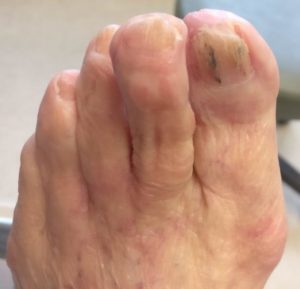
How to fix toenail fungus:
- There are many different types of toenail damage.
- In our experience, about 90% or more is related to toenail fungus.
- The key to toenail fungus is to trim it as much as possible and file that nailed down.
- If you are able to do that, you have to make sure you can kill fungus the rest of the way.
- The best way to do that is to soak exfoliate the affected toenail skin. So, consider foot soaks.
- At the same time, you have to apply antifungal medication such as these medications recommended here or the toenail repair pens.
Best Toenail Repair Products:
Best Toenail Repair Pen.
Top Choice For Direct Toenail Application.
Great Option For Foot Soak.
Great Tea Tree Oil Treatment




Price:
$14.44
$22.88
$17.97
Price not available
Overview:
4 Pens with quick dry application that leaves a sealing lid on top. Easy to store and apply. Key is still to trim/file the toenail first!
All natural option that is toxic to fungus. This is similar to tea tree oil in that respect but can be more effective. You still need to exfoliate dead skin and trim thick toenails.
Safe, cost effective and relaxing all at the same time! This needs to be used in a 20 minute foot soak. Works well for exfoliating loose skin/toenail as well as softening.
Tea Tree Oil is well studied and an all natural anti-fungal treatment.
Pros:
Easy to use, quick drying. This fills into the cracks and seals them with minimal mess. This is great for sealing even dehydrated keratin granulations.
All natural, relatively cost effective. 1,000s of reviews with excellent results. Very clean and quick drying, easy to apply.
Very safe, little risk, low cost and very effective if used correctly. The key is to use it as an aid to soften and exfoliate loose/dry dead skin and toenail.
Great reviews at 4.7/5 at 500+ overall reviews. Well proven and natural option.
Cons:
0% chance of working if your toenail is loose and has no blood supply. Make sure you trim and file any loose finger or toenail. Otherwise “0% CHANCE OF WORKING!” You cannot restore a dead toenail without blood flow.
Small amount and a little more expensive than some other options. Once more has 0% chance of working if your goal is to heal a dead, detached toenail or dry skin. Are you noticing this is a trend? This is really the key!
It once more has 0% chance working if you are trying to save loose and dead crusty skin. Fungus will always grow on this if no blood flow. It can not regenerate dead skin, only exfoliate it.
Not the greatest amount of solution, the all natural solutions can be more expensive.
Crucial Tips:
There is some evidence that these active ingredients work, just be aware: These are not FDA approved and massively studied medications!
There is some evidence that these active ingredients work, just be aware: These are not FDA approved and massively studied medications!
There is some evidence that these active ingredients work, just be aware: These are not FDA approved and massively studied medications!
Although tea tree oil does nave studies and is antifungal, it is not an FDA approved medication and not studied for this specific use.
Affiliate Link (Buying through these links will connect you to Amazon):
Best Toenail Repair Products:
Best Toenail Repair Pen.

Price:
$14.44
Overview:
4 Pens with quick dry application that leaves a sealing lid on top. Easy to store and apply. Key is still to trim/file the toenail first!
Pros:
Easy to use, quick drying. This fills into the cracks and seals them with minimal mess. This is great for sealing even dehydrated keratin granulations.
Cons:
0% chance of working if your toenail is loose and has no blood supply. Make sure you trim and file any loose finger or toenail. Otherwise “0% CHANCE OF WORKING!” You cannot restore a dead toenail without blood flow.
Crucial Tips:
There is some evidence that these active ingredients work, just be aware: These are not FDA approved and massively studied medications!
Affiliate Link (Buying through these links will connect you to Amazon):
Best Toenail Repair Products:
Top Choice For Direct Toenail Application.

Price:
$22.88
Overview:
All natural option that is toxic to fungus. This is similar to tea tree oil in that respect but can be more effective. You still need to exfoliate dead skin and trim thick toenails.
Pros:
All natural, relatively cost effective. 1,000s of reviews with excellent results. Very clean and quick drying, easy to apply.
Cons:
Small amount and a little more expensive than some other options. Once more has 0% chance of working if your goal is to heal a dead, detached toenail or dry skin. Are you noticing this is a trend? This is really the key!
Crucial Tips:
There is some evidence that these active ingredients work, just be aware: These are not FDA approved and massively studied medications!
Affiliate Link (Buying through these links will connect you to Amazon):
Best Toenail Repair Products:
Great Option For Foot Soak.

Price:
$17.97
Overview:
Safe, cost effective and relaxing all at the same time! This needs to be used in a 20 minute foot soak. Works well for exfoliating loose skin/toenail as well as softening.
Pros:
Very safe, little risk, low cost and very effective if used correctly. The key is to use it as an aid to soften and exfoliate loose/dry dead skin and toenail.
Cons:
It once more has 0% chance working if you are trying to save loose and dead crusty skin. Fungus will always grow on this if no blood flow. It can not regenerate dead skin, only exfoliate it.
Crucial Tips:
There is some evidence that these active ingredients work, just be aware: These are not FDA approved and massively studied medications!
Affiliate Link (Buying through these links will connect you to Amazon):
Best Toenail Repair Products:
Great Tea Tree Oil Treatment

Price:
Price not available
Overview:
Tea Tree Oil is well studied and an all natural anti-fungal treatment.
Pros:
Great reviews at 4.7/5 at 500+ overall reviews. Well proven and natural option.
Cons:
Not the greatest amount of solution, the all natural solutions can be more expensive.
Crucial Tips:
Although tea tree oil does nave studies and is antifungal, it is not an FDA approved medication and not studied for this specific use.
Affiliate Link (Buying through these links will connect you to Amazon):
Recommended foot fungus products:
- It is also very important to fix your foot fungus.
- Even if you cure your toenail fungus, keep your toenails trimmed in healthy: it is possible for your foot fungus to spread back into toenails.
- So make sure you treat your foot fungus, as well as your toenail fungus.
Best Foot Fungus Products
Best Foot Powder Option For Shoes.
Best Shower Body Wash
Best choice for Foot Bath Mix
Best & Most Cost Effective Foot Soak Tub.




Price:
$26.31
$17.99
$16.95
$18.97
Overview:
3 pack of foot powder spray. This is great for shoes and feet, but not as practical outside the foot or shoe.
Great cost effective shower wash.
Mix of epsom salts, tea tree oil for a good price.
This is a cost effective tub for foot soaks. You still need to also buy a foot soak powder or solution!
Pros:
If you sweat in your shoes, this is your best bet. This will soak up sweat and kill fungus. Very effective and excellent Amazon reviews. 3 pack online is the price of one bottle at the store.
Over 5,000 5 star amazon reviews. Great reviews, medically proven component in tea tree oil. All natural with excellent results.
Epsom salts and tea tree oil have proven effect. Epsom salts make your loose skin flake off and tea tree oil is anti-fungal. Great price and near 5 star review on Amazon.
Excellent choice for cost effective foot soak tub. Top notch reviews on amazon, great price.
Cons:
Powder makes a big mess. Good for shoes but it can get powder inside your shoes. Can have chemical like smell.
Can be more expensive than regular soap. It may not be enough by itself without soaking or especially further toenail treatment.
Foot soak by itself may not be enough to fix your problem, but a component. You also need a foot tub.
Not much downsides, it’s a tub! But you have to get foot soak powder or antifungal solution separately.
Affiliate Link (Buying through these links will connect you to Amazon):
Best Foot Fungus Products
Best Foot Powder Option For Shoes.

Price:
$26.31
Overview:
3 pack of foot powder spray. This is great for shoes and feet, but not as practical outside the foot or shoe.
Pros:
If you sweat in your shoes, this is your best bet. This will soak up sweat and kill fungus. Very effective and excellent Amazon reviews. 3 pack online is the price of one bottle at the store.
Cons:
Powder makes a big mess. Good for shoes but it can get powder inside your shoes. Can have chemical like smell.
Affiliate Link (Buying through these links will connect you to Amazon):
Best Foot Fungus Products
Best Shower Body Wash

Price:
$17.99
Overview:
Great cost effective shower wash.
Pros:
Over 5,000 5 star amazon reviews. Great reviews, medically proven component in tea tree oil. All natural with excellent results.
Cons:
Can be more expensive than regular soap. It may not be enough by itself without soaking or especially further toenail treatment.
Affiliate Link (Buying through these links will connect you to Amazon):
Best Foot Fungus Products
Best choice for Foot Bath Mix

Price:
$16.95
Overview:
Mix of epsom salts, tea tree oil for a good price.
Pros:
Epsom salts and tea tree oil have proven effect. Epsom salts make your loose skin flake off and tea tree oil is anti-fungal. Great price and near 5 star review on Amazon.
Cons:
Foot soak by itself may not be enough to fix your problem, but a component. You also need a foot tub.
Affiliate Link (Buying through these links will connect you to Amazon):
Best Foot Fungus Products
Best & Most Cost Effective Foot Soak Tub.

Price:
$18.97
Overview:
This is a cost effective tub for foot soaks. You still need to also buy a foot soak powder or solution!
Pros:
Excellent choice for cost effective foot soak tub. Top notch reviews on amazon, great price.
Cons:
Not much downsides, it’s a tub! But you have to get foot soak powder or antifungal solution separately.
Affiliate Link (Buying through these links will connect you to Amazon):
Best Shoes For Toenail Injuries:
- The key to prevent toenail ripping and lifting is to have a pair of good supportive shoes.
- If you have a good supportive shoe that keeps pressure off your toes in your toenails, there will be no lifting and cracking to allow bacteria and fungus to get in.
- This almost seems counter-intuitive, but when people make a switch to really good supportive shoes that fit properly, their toenail problems almost always get better over the next few months or a year.
- Your current nail is already likely destroyed, especially with joggers toe, but let the new nail growing healthy without new damage.
- Click the following link for our most recommended shoes. Try to focus on shoes with mesh and room around the big toe and also the smaller toes.
Walk This Way: Trusted Foot & Ankle Information
Learn what’s hurting and how to fix it.
Why Choose Balance Foot & Ankle Specialist in Howell and Bloomfield Hills?
Our experienced podiatric surgeons combine precision, care, and innovation to deliver successful outcomes in flatfoot reconstruction. With modern facilities, patient education, and compassionate care, we’ve become the trusted choice for foot and ankle surgery in Southeast Michigan. We’re committed to restoring your stride—comfortably and confidently.
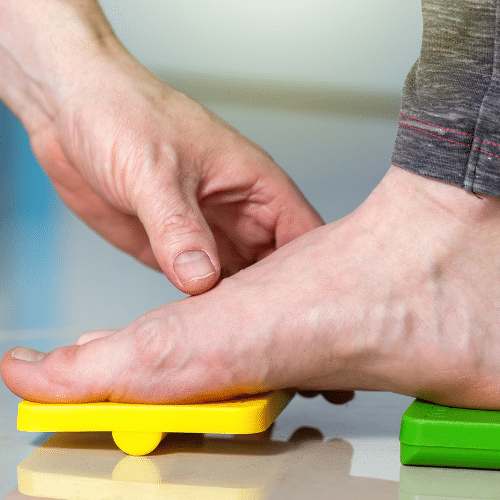
Toenail Pain (Toenail Fungus, Ingrown Toenails, Discolored Toenails)
Frequently Asked Questions: Bruise (Subungual Hematoma) Under the Big Toenail
A subungual hematoma is bleeding trapped beneath the toenail—often caused by trauma like dropping something on it or repetitive pressure in tight shoes. It causes visible discoloration (red, purple, brown, or black) and throbbing pain due to pressure buildup under the nail.
Impact injuries (e.g. a heavy object hitting your toe or stubbing it hard), and
Repeated micro‑trauma from ill‑fitting footwear (often seen in runners or hikers).
Immediate pressure, throbbing pain, and tenderness under the nail,
Discoloration ranging from red or purple to dark brown or black as the blood clots, and
In some cases, nail lifting (onycholysis) as the blood separates the nail from the bed.
If the stain covers 25% or less of the nail and you’re tolerating the pain, you can:
- Elevate the foot, Apply ice wrapped in cloth for 10–15 minutes intermittently,
- Take an over-the-counter NSAID if appropriate, and
- Protect the nail do not attempt to drill or pierce it yourself.
- It usually heals slowly over time as the nail grows out.
Nail trephination: a sterile hole (via electric cautery or needle) is made to relieve pressure and drain blood. It’s quick and effective if done within 48 hours.
Nail removal (partial or complete): if the nail or nail bed is severely damaged or fractured. Often followed by local anesthesia and bed repair.
- The pain from pressure typically improves within days after drainage.
- The toenail itself may take 6–9 months to fully grow out and return to clarity, depending on age and nail growth rate.
- Wear properly fitting shoes with sufficient toe room—tight shoes are a leading cause.
- Trim toenails straight across and keep them at a moderate length to avoid pressure from curling or ingrown nails.
- Use cushioned or anatomically supportive socks, especially if you run, hike, or participate in sports.
- Rest or ice early after minor injury to reduce blood buildup.


